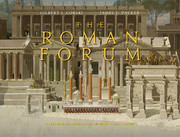Book contents
- Frontmatter
- Map
- Contents
- Preface
- Acknowledgments
- Part I. Architecture in the Roman Forum during the Empire: A Brief History
- Part II. The Monuments
- 3 The Temple of Antoninus and Faustina
- 4 The Temple of Caesar (Aedes divi Iuli)
- 5 The Basilica Æmilia
- 6 The Curia
- 7 The Arch of Septimius Severus
- 8 Minor Monuments
- 9 The Temple of Concord
- 10 The Temple of Vespasian
- 11 The Tabularium
- 12 The Portico of the Dei Consentes
- 13 The Temple of Saturn
- 14 The Basilica Julia
- 15 The Arch of Tiberius
- 16 The Schola Xanthi
- 17 The Diocletianic Honorary Columns
- 18 The Temple of Castor and Pollux
- 19 The Parthian Arch of Augustus (19 BCE)
- 20 The Temple of Vesta
- Part III. Conclusions
- Glossary
- Notes
- Bibliography
- Sources for Coin Images from the Internet and for Other Images
- Index
9 - The Temple of Concord
from Part II. - The Monuments
Published online by Cambridge University Press: 05 March 2015
- Frontmatter
- Map
- Contents
- Preface
- Acknowledgments
- Part I. Architecture in the Roman Forum during the Empire: A Brief History
- Part II. The Monuments
- 3 The Temple of Antoninus and Faustina
- 4 The Temple of Caesar (Aedes divi Iuli)
- 5 The Basilica Æmilia
- 6 The Curia
- 7 The Arch of Septimius Severus
- 8 Minor Monuments
- 9 The Temple of Concord
- 10 The Temple of Vespasian
- 11 The Tabularium
- 12 The Portico of the Dei Consentes
- 13 The Temple of Saturn
- 14 The Basilica Julia
- 15 The Arch of Tiberius
- 16 The Schola Xanthi
- 17 The Diocletianic Honorary Columns
- 18 The Temple of Castor and Pollux
- 19 The Parthian Arch of Augustus (19 BCE)
- 20 The Temple of Vesta
- Part III. Conclusions
- Glossary
- Notes
- Bibliography
- Sources for Coin Images from the Internet and for Other Images
- Index
Summary
The Republic
Roman tradition credited the vow to build the Temple of Concord to Marcus Furius Camillus, dictator, conqueror of the Etruscans. In the midst of the plebeian fight to obtain admission to the consulship from the patricians in 367 BCE, “turning to the Capitol, he [Camillus] prayed the gods to bring the present tumults to their happiest end, solemnly vowing to build a temple to Concord when the confusion was over.” According to the poet Ovid, “he kept his vow,” but archaeological remains of this early monument have been difficult to identify, and it may not have been built after all. Indeed, the first shrine to Concord on the site seems to have been founded by Gnaeus Flavius, a curule aedile, the son of a former slave, despised by the patricians for his humble origins and popular measures.
He published the formulae of the civil law, which had been filed away in the secret archives of the pontiffs, and posted up the calendar on white notice boards about the Forum, that men might know when they could bring an action [a legal suit]. He dedicated a temple of Concord in the precinct of Vulcan, greatly to the resentment of the nobles; and Cornelius Barbatus, the chief pontiff, was forced by the unanimous wishes of the people to dictate the words to him, though he asserted that by custom of the elders none but a consul or a commanding general might dedicate a temple. So, in accordance with a senatorial resolution, a measure was enacted by the people providing that no one should dedicate a temple or an altar without the authorization of the senate or a majority of the tribunes of the plebs.
- Type
- Chapter
- Information
- The Roman ForumA Reconstruction and Architectural Guide, pp. 165 - 183Publisher: Cambridge University PressPrint publication year: 2015



